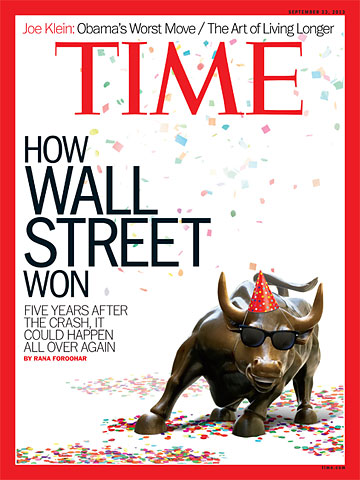
Correction Appended: Sept. 13, 2013
Five years on from the financial crisis, the disaster that was Lehman Brothers and its brutal, economy-shredding aftermath can seem a distant memory. We're out of the Great Recession, and growth is finally back. America's biggest banks are making record profits. The government is even earning money from its bailouts of institutions like AIG, Fannie Mae and Freddie Mac. The Obama Administration, which is pushing hard to complete the new financial rules mandated by the Dodd-Frank reform act deserves credit for making our financial system safe--or that's the line being tossed around by current and past members of the crisis team.
But amid all the backslapping, a larger truth is being lost. The financialization of the American economy, a process by which we've become inexorably embedded in Wall Street, just keeps rolling on. The biggest banks in the country are larger and more powerful than they were before the crisis, and finance is a greater percentage of our economy than ever. For a measure of this, look no further than the Dow Jones industrial average, which just ditched Alcoa, Hewlett-Packard and retail lender Bank of America in favor of the most high-flying investment bank of all, Goldman Sachs.
Given all this, is your money really any safer over the long haul than it was five years ago? And have we restructured our financial industry in a way that will truly limit the chances of another crisis? The answer is still not an unequivocal yes, because banking is as complex and globally intertwined as ever. U.S. financial institutions remain free to gamble billions on risky derivatives around the world. A crisis in Europe, for instance, could still potentially devastate a U.S. institution that made a bad bet--and send shock waves through other key sectors, like the $2.7 trillion held in U.S. money-market funds, much of which is owned by Main Street investors who believe these funds are just as safe as cash.
Although this scenario isn't necessarily probable--many U.S. banks have reduced risk and increased capital--it is possible. We're relying on the banks' good intentions and self-interest, a strategy that didn't work out so well before. The truth is, Washington did a great job saving the banking system in '08 and '09 with swift bailouts that averted even worse damage to the economy. But swayed too much by aggressive bank lobbying, it has done a terrible job of reregulating the financial industry and reconnecting it to the real economy. Here are five things that are still badly needed to reduce the risks for everyone.
No. 1
Fix the Too-Big-To-Fail Problem
When the meltdown struck, everyone was forced to confront the concept of "too big to fail"--the idea that some banks are so large and so integral to the economy that they must be bailed out at any cost to avert systemic catastrophe. Crisis after crisis over the past year or so--from JPMorgan Chase's $7 billion in losses from wagers by the trader nicknamed the London Whale to the revelations about how some banks rigged the critical LIBOR interest rate--has proved that trouble at big institutions can still affect the broader economy and that Wall Street is as unconcerned with the fortunes of Main Street as ever.
